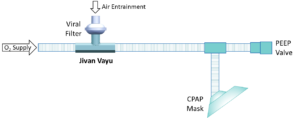In news
Recently, IIT Ropar has developed nation’s first power-free CPAP device ‘Jivan Vayu
About Jinav Vayu CPAP device
- It is Nation’s first such device which functions even without electricity and is adapted to both kinds of oxygen generation units like O2 cylinders and oxygen pipelines in hospitals.
- These provisions are not available in otherwise existing CPAP machines.
- Jivan Vayu’ can be used as a substitute for Continuous Positive Airway Pressure (CPAP) machine

- CPAP is a treatment method for patients having breathing problems during sleep called sleep apnea.
- The machine uses mild air pressure to keep the airways open for easy breathing. It is also used to treat infants whose lungs have not fully developed.
- The machine blows air into the baby’s nose to help inflate his or her lungs.
- The treatment is all the more necessary during early stages of the Covid-19 infection.
- It reduces lung damage and allow patients to recover from the inflammatory effects
- Fulfilling all the medically required parameters, this leak-proof, low-cost CPAP delivery system, “Jivan Vayu’ is designed for a 22mm CPAP closed circuit tube.
- It can even be customized as per the size of the tube. Since it can run during power failures, this can be used to safely transport a patient.
- It has an inbuilt viral filter at the air entrainment end which has a viral efficacy of 99.99%.
- The viral filter ensures that the air does not bring in any pathogens from the environment.
- The device has been manufactured using 3D printing and has also been tested mechanically.
- ‘Jivan Vayu’ can deliver high flow oxygen (20–60 LPM) while maintaining a continuous positive pressure of up to 20 cm H2O.
- The device is designed to maintain an FiO2 of above 40% with a PEEP (positive end-expiratory pressure) of 5-20 cm H2O.
Difference between Oxygen Concentrator and Oxygen Cylinder
- Concentrators work like an oxygen cylinder, supplying oxygen through the use of masks or nasal tubes.
- However, cylinders need refilling, while oxygen concentrators can work 24×7 using electricity.
- Oxygen concentrators are portable and easy-to-carry alternatives to massive cylinders.
- Concentrators are not the best option for those suffering from severe comorbidities and complications because they can only provide 5-10 litres of oxygen per minute, which may not be enough for patients who have severe complications.
- There are two types of oxygen concentrators. These are namely continuous flow and pulse.
- While a continuous flow oxygen concentrator provides the same flow of oxygen in a minute until it’s been turned off, pulse dose identifies the patient’s breathing pattern and gives out oxygen when it detects inhalation.
















